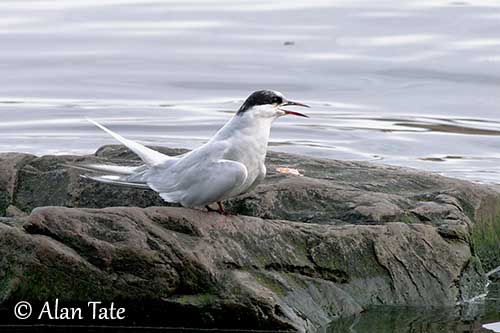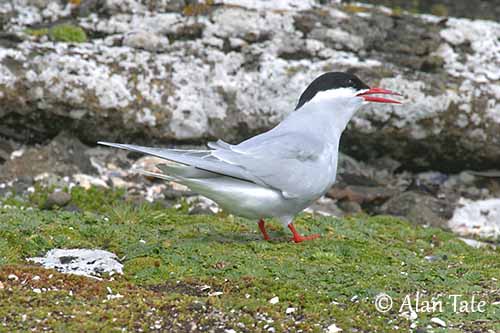
Fr: Sterne couronnée
Ang: Antarctic Tern - Swallow-tailed Tern
All: Antarktikseeschwalbe
Esp: Charrán Antártico
Ita: Sterna antartica
Nd: Zuidpoolstern
Sd: Antarktistärna
Photographers:
Otto Plantema
Trips around the world
Alan & Ann Tate
AA Bird Photography
Text by Nicole Bouglouan
Sources:
HANDBOOK OF THE BIRDS OF THE WORLD Vol 3 by Josep del Hoyo-Andrew Elliott-Jordi Sargatal - Lynx Edicions - ISBN : 8487334202
A Complete Guide to Antarctic Wildlife by Hadoram Shirihai and Illustrated by Brett Jarrett - Edited by Guy M. Kirwan - ALUL.A Press Oy, Finland - ISBN 9519894705
BirdLife International (BirdLife International)
Australian Antarctic Division: Leading Australia's Antarctic Program
Department of Sustainability, Environment, Water, Population and Communities
Biodiversity Explorer – The Web of Life in Southern Africa
Antarctic Tern
Sterna vittata
Charadriiformes Order - Laridae Family
INTRODUCTION:
The Antarctic Tern ranges throughout the southern oceans and breeds on several subantarctic islands. It is gregarious while breeding in loose colonies and fishing in large flocks. The adults often co-operate to defend chicks and nests against predators.
The species is threatened by introduced mice, cats and rats to some islands, but most of the breeding areas are now predator-free islands.
Six subspecies are currently recognized, but some of them are matter of some debate and will become probably full species.
DESCRIPTION OF THE BIRD:
Biometrics:
Length: 35-40 cm
Wingspan: 75 cm
Weight: 150-180 g
The adult has grey upperparts including the upperwing where the outer primaries show variably grey to black outer webs. The rump and the deeply forked tail are white.
The underparts are greyish-white with white undertail-coverts.
On the head, forehead, crown and nape are black, contrasting with the white cheeks. Chin and malar area are greyish-white like the underparts.
Bill, legs and feet are red. The eyes are dark brown.
Both adults are similar.

The non-breeding adult has white forehead whereas the crown is streaked with white. The underparts are white. Bill, legs and feet vary from dark reddish to dull red.
The juvenile is initially marked buff, grey and white on the upperparts, with conspicuous buff flanks. The bill is blackish. Legs and feet are dull reddish.
The first year has white forehead and whiter underparts. The bill is dull reddish black.
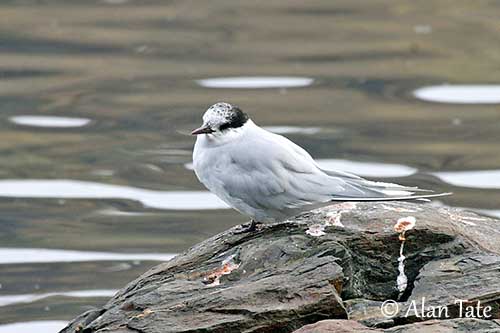
SUBSPECIES AND RANGE:
The Antarctic Tern has six subspecies which differ in size and plumage tone.
S.v. tristanensis is found on Tristan da Cunha and Gough Island.
S.v. georgiae is found in South Georgia, South Orkney Islands, South Sandwich Islands and Bouvet Island.
S.v. gaini occurs in South Shetland Islands and Antarctic Peninsula (S to Marguerite Bay).
S.v. vittata is found on Prince Edward, Marion, Crozet, Kerguelen, and Heard Islands in S Indian Ocean.
S.v. sanctipauli occurs on Amsterdam and St Paul Islands in S Indian Ocean.
S.v. bethunei is found on Stewart Island, and Snares, Auckland, Campbell, Macquarie, Bounty and Antipodes Islands.
The race “gaini” is the largest, followed by the race “tristanensis”. The race “georgiae” is the smallest but it has longer wings.
HABITAT:
The Antarctic Tern breeds on rocky islands on cliffs and offshore stacks, on headlands, ridges, usually on rocky, gravel or sandy beaches and scattered scrubs.
It nests in inaccessible areas to avoid predation by introduced cats and rats, often on cliff ledges and offshore stacks.
Outside the breeding season, the Antarctic Tern can be seen at the edge of the ice in Antarctica, and on beaches and rocky headlands in South Africa.
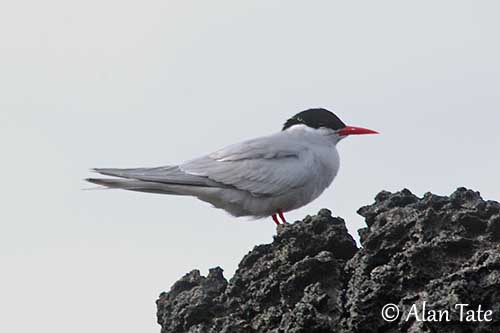
CALLS AND SONGS: SOUNDS BY XENO-CANTO
The Antarctic Tern gives a shrill high-pitched “trr-trr-kriah” both in flight and when fishing. A continuous chattering can be heard at communal roosts. It gives screams and squawks in alarm. During the displays, they give loud “chit… chit… chit… chirr, chirr, chirr…”
BEHAVIOUR IN THE WILD:
The Antarctic Tern feeds primarily on small fish, but it also consumes limpets, euphausiids and crustaceans. It may takes occasionally some insects and offal.
During the breeding season, it forages in inter-tidal and inshore waters near the breeding sites. It is more pelagic during winter.
The Antarctic Tern performs plunge-diving and contact-dipping, and hovering at 2-10 metres above the water before dipping or diving. This technique is used only in calm waters.
It forages singly or in flocks, and may follow the ships for offal. It sometimes forages on the ground, especially in open pastures on Tristan da Cunha.
Some birds may defend their feeding area, chasing away other terns while uttering a loud “chrrrrrr”.
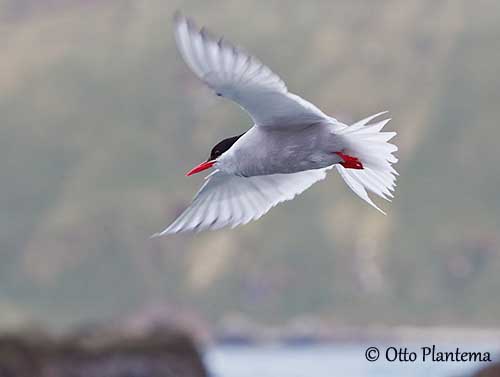
During the breeding season, the Antarctic Tern is territorial and defends the nest-site against intruders, performing repeated dive-bombing and striking them with the bill.
They form loose colonies of 5-20/40 pairs, sometimes much more in some areas. But it also nests solitary.
Mates are generally monogamous. Courtship includes aerial displays and courtship feeding by male to female.
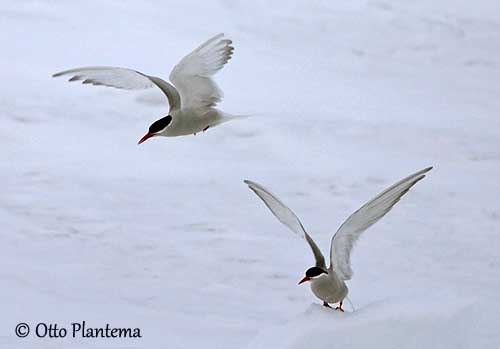
The Antarctic Tern, adults and young, leave the breeding grounds after the young fledge. Several populations may remain close to their breeding grounds, whereas other flocks from the southern parts of the range may travel long distances to South America (race “georgiae”) and South Africa (race “tristanensis”). This species is vagrant to Australia.
The flight is swift and graceful, enhanced by the deeply forked tail and the long streamers.
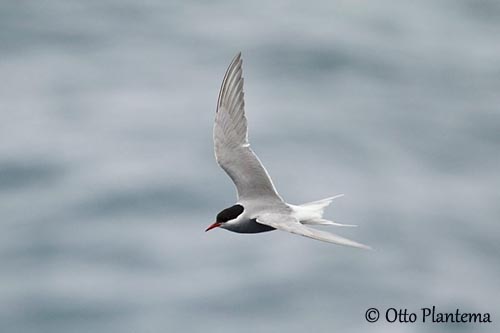
REPRODUCTION OF THIS SPECIES:
The breeding season takes place mainly in November/December, with some variations according to range, climate and food availability. The Antarctic Tern forms loose colonies but also nests often solitary.
The nest is a shallow depression on rock, cliff ledge, soil, sand or grassy ground. It may contain some shells or pebbles, or flattened vegetation.
The female lays 1-2 eggs and both adults incubate during 23-25 days. At hatching, the chicks have buff down with black spotting above, and greyish-white down below, but the throat is darker. They are fed by their parents and fledge 27-32 days after hatching. They are still fed by the adults for some days more.
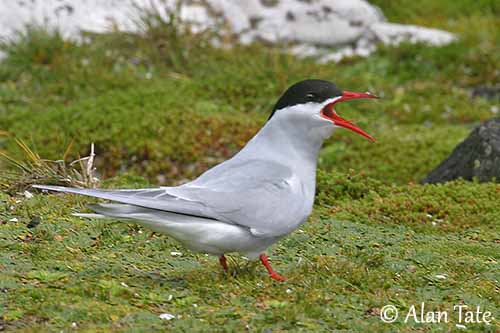
Gulls and skuas are the main nest-predators, although on the Antipodes, the breeding success is affected by mice and on Auckland Island by mice, cats and pigs.
PROTECTION / THREATS / STATUS:
The Antarctic Tern has wide range, but it is vulnerable to human disturbances and introduced predators.
Total population is unknown but must be about 50,000 pairs, with the main population of about 35,000 pairs on South Shetlands.
However, the Antarctic Tern is currently evaluated as Least Concern.
